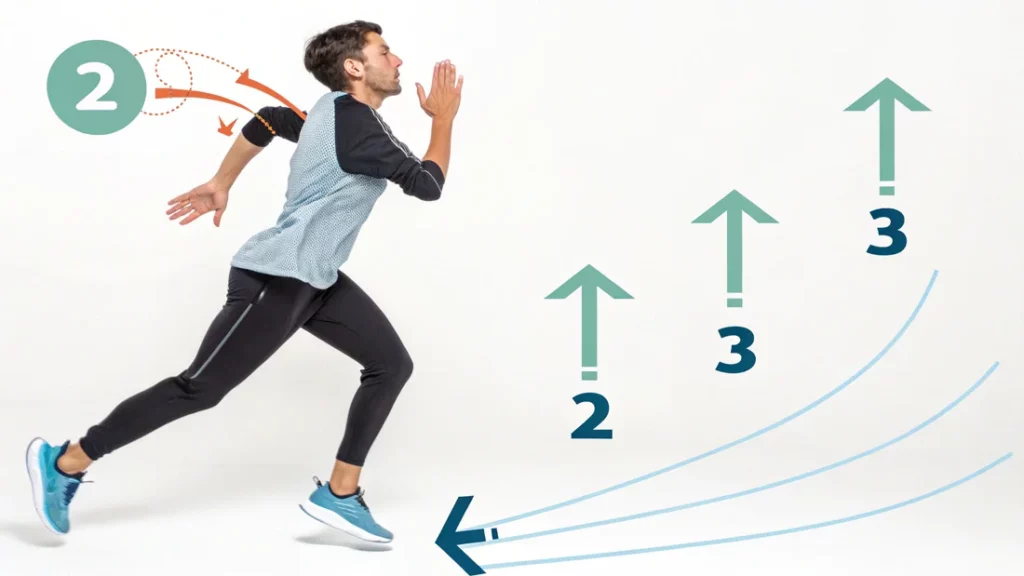Are you pushing yourself hard during workouts but still finding yourself struggling to maintain your stamina and endurance?
What if a simple, yet powerful technique could help you unlock a new level of performance?
Enter paced breathing, also known as rhythmic breathing – a method that allows you to take control of your breath and use it as a tool to maximize both your stamina and your endurance.

In this post, you’ll discover how to integrate paced breathing into your workouts, and also understand how you can transform your fitness journey.
What Is Paced Breathing (Rhythmic Breathing)?
So, what is paced breathing, and how can it help you improve your performance?
Paced breathing, often referred to as rhythmic breathing, is a technique that involves consciously controlling your breathing and coordinating it with your body’s movements.
This method goes beyond simply inhaling and exhaling, and it is designed to enhance your stamina and endurance by creating a more efficient exchange of oxygen.

It is a method that is simple, yet powerful.
- Implementing Paced Breathing:
- When implementing paced breathing, you should focus on taking a specific number of breaths with your steps, your reps or your movements. For example, you could try inhaling for two steps, and exhaling for two steps when you are running, or inhaling for two repetitions, and exhaling for two repetitions when performing weightlifting. The key is to focus on how your body feels, and adjust it accordingly. By making your breath match your movements, you are improving your overall efficiency, which helps to improve endurance, and enhance your overall stamina.
- Benefits of Paced Breathing:
- This technique not only improves your breathing but also promotes a more efficient exchange of oxygen, which allows you to conserve your energy and enhance your overall stamina. By coordinating your breathing with your movement, your body is able to work more effectively, which will lead to an improvement in overall performance.
The Benefits of Paced Breathing for Stamina and Endurance
Now that you have a solid understanding of what paced breathing is and how to perform it, let’s dive deeper into the specific benefits that it provides to your stamina and endurance.
By coordinating your breath with your movements, you are able to perform more efficiently, which will lead to longer, more effective workouts.

How Paced Breathing Improves Stamina
- Optimized Oxygen Intake:
- Paced breathing is designed to ensure that your body receives a consistent supply of oxygen, which is essential for maintaining stamina during physical activity. It helps you to take full breaths, which then allows you to power through workouts for longer periods of time, without feeling short of breath.
- By fully engaging your diaphragm, you are optimizing your oxygen intake, which has a direct link to stamina, and overall fitness.
- Efficient Energy Use:
- When your body works efficiently, you will use less energy, which means you can perform at a high level for a longer duration. By practicing paced breathing, you are making it easier for your body to work, which helps to optimize energy use.
- This method helps to reduce any unnecessary effort from your body, and ensures that you are getting the most out of your breath and your movement.
- Prolonged Activity:
- By using paced breathing, you are making it easier for your body to maintain higher levels of performance and to sustain activity for longer. This helps you to push yourself harder during training, and see consistent results over time.
- By making it easier for your body to function, you are making it easier to maintain your performance for the entire duration of your workout.
How Paced Breathing Improves Endurance
- Muscle Efficiency:
- Paced breathing helps to improve muscle efficiency, which means that your muscles work harder, and also work more efficiently for longer. This helps to reduce fatigue, as it also reduces the amount of strain and effort that your muscles are putting in.
- By making your muscles work more efficiently, it will also help to improve your overall endurance, and help to reduce muscle fatigue, which may reduce soreness.
- Reduced Fatigue:
- When you are not breathing correctly, you can very easily tire out faster during exercise. With paced breathing, you will be making it easier for your body to perform which will reduce feelings of fatigue, and allow you to perform for much longer. This has a direct correlation with overall endurance and also stamina.”
- By using this method effectively, you are optimizing your body’s ability to perform for extended periods.
- Energy Conservation:
- By consciously coordinating your breath with your movement, you are conserving your energy and making it easier for your body to breathe. This also helps you to sustain a steady pace and to prolong your performance.
- The optimization of energy use is directly linked to greater endurance, as this will allow you to push yourself further for longer periods of time.
Research & Evidence
Research has shown that paced breathing can help to improve an athlete’s performance and efficiency, which has a direct correlation to improved stamina and endurance.
It has been proven to help individuals push themselves further, for longer, and with less effort.
You can also read the personal journeys of some individuals who have implemented paced breathing, and have found it to be highly beneficial.
Integrating Paced Breathing Into Your Workouts
Now that you understand the many benefits of paced breathing, let’s explore how you can integrate this simple technique into your workouts.
Paced breathing can be easily used in a variety of different workouts, and it’s a valuable tool that all athletes can benefit from.

Key Implementation Strategies
- Running:
- When running, use paced breathing by coordinating your breath with your steps. For example, you could inhale for two steps and exhale for two steps. This type of rhythmic breathing will help you to maintain a steady pace, and also increase your stamina and endurance.
- During long-distance runs or marathons, paced breathing can be especially useful to help you conserve energy and also improve your lung capacity.
- Cycling:
- Paced breathing is also very effective for cycling. You can use it in the same way as you would for running, coordinating your breaths with the pedalling of your feet.
- During uphill cycling, you may need to increase the frequency of your breath. However, on flat terrains, it is best to find a rhythmic and even breath pattern.
- This method will help you to maintain your rhythm and power output, whilst conserving your energy, and is also a method you can use on long-distance rides.
- Weightlifting:
- For weightlifting, you can use paced breathing during your repetitions. For example, you could inhale during the eccentric phase (lowering the weight), and exhale during the concentric phase (lifting the weight).
- By doing this, you are providing your muscles with oxygen at the correct time, and also improving your breath control, which will help you to perform each movement more efficiently and with greater focus.
- This is also especially useful for heavy lifts, as it provides the necessary support, which will also improve your overall stamina.
- Other Activities:
- Paced breathing can be used in various other activities such as HIIT training, swimming, yoga, and even walking. The key is to find a rhythm that matches your pace and your activity and that feels comfortable for you.
- You can then adapt the method to best suit your individual needs, and to match your activity level.
Practical Tips For Paced Breathing
To make paced breathing a seamless part of your workout routine, here are some practical tips that will set you up for success.
Remember that these tips are here to guide you, and you should feel comfortable adapting these to best suit your needs.
Key Tips
- Start Simple:
- When you are first starting out with paced breathing, try to keep the method simple. There is no need to overcomplicate things or try to perform it perfectly. It’s important to focus on the rhythm and the coordination between your breath and your movements.
- Focus on the basic principles, and remember to be patient with yourself, as mastery of a new technique takes time and practice.
- Be Consistent:
- As with any new habit, consistency is the key to success. It is far more effective to practice this method regularly, than to only use it sporadically. Try to use it in as many of your workouts as possible so that you are gaining a consistent benefit.
- By turning it into a daily habit, you will find that it is more natural and easier to implement, which will also provide you with better long-term results.
- Be Mindful:
- When you are performing paced breathing, focus on how your body is feeling. Pay attention to your breath, your body and how you are coordinating your breath and your movement.
- Being mindful will help you to better understand the method, and will also improve the benefits that you will receive.
- Adjust Your Patterns:
- Remember that your breath patterns should be adaptable and flexible, and that you should not be rigid with your approach. You can and should adjust your patterns as needed, to suit your specific needs, and to also match what you are doing.
- You may find that you are using a different breath pattern for different types of workouts. This is completely normal, and the key is to listen to your body and do what feels right.
Frequently Asked Questions About Paced Breathing
To further enhance your understanding of paced breathing, I have compiled a list of frequently asked questions.
By answering these, you will have a much clearer understanding of the method, and it will also help you to get the most out of your practice.
These are real questions asked by real people, which will help you to better understand the method.
- Question 1: What is the best ratio for paced breathing?
- Answer: The best ratio for paced breathing will depend entirely on the activity you are doing, and your individual preferences. However, most people find that using a 1:1 ratio such as inhaling for 2 steps and exhaling for 2 steps (or 4 and 4, etc) to be very effective. The key is to match your breathing rhythm with your movement, to ensure that it is smooth and even. It is also very important to always listen to your body, and adjust your method accordingly.
- Question 2: Can you use paced breathing for strength training?
- Answer: Yes, paced breathing is a fantastic method to use for strength training. As you are lifting weights, try to inhale as you are lowering the weight, and exhale as you are lifting it. This will ensure that your breathing is in sync with your movements, and that you are getting an optimal flow of oxygen to your muscles, which is key to getting the most out of each rep. You may also find that implementing this method is beneficial for heavy lifts.
- Question 3: How does paced breathing improve performance?
- Answer: Paced breathing helps to improve athletic performance in a number of ways. It improves stamina and endurance by making your body more efficient, which helps you to perform for longer without tiring, and it also helps to conserve your energy, which means that you have more power and strength throughout your workouts. It is an amazing method to help you level up your overall performance.
- Question 4: Is paced breathing good for recovery?
- Answer: While paced breathing is not primarily focused on muscle recovery, it can be beneficial when used as part of your post-workout routine. By using a mindful and relaxed method of breathing, you are helping to activate your parasympathetic nervous system, which allows your body to rest, and your muscles to start to repair. Although other methods may be more powerful for recovery, this method will help to improve your overall calm, which is an important factor for a quick and effective recovery.
My Final Thoughts On Paced Breathing
As we reach the end of this exploration into paced breathing, I hope that you now understand how powerful this method can be, and how it can help to transform your workouts.
This is a tool that can be used in a variety of settings, which makes it so versatile and also so effective.
We’ve uncovered the science of paced breathing, how it can boost your stamina and endurance, and also how to implement it into various aspects of your workout routine.
Paced breathing can be used by athletes of all skill levels, and can truly enhance your performance, and improve your workout experience.
It is a method that can easily be integrated into your daily life, and it also comes with no extra equipment, which makes it incredibly accessible for all.
I encourage you to start experimenting with paced breathing in your next workout, and to see how it feels for yourself.
The most important thing is to practice regularly, and to allow your body to adapt to this new rhythm.
I also encourage you to explore the many other breathing techniques that are out there, and to see which ones resonate with your body and your mind.
Now go forth and breathe!
Related Posts
No posts
